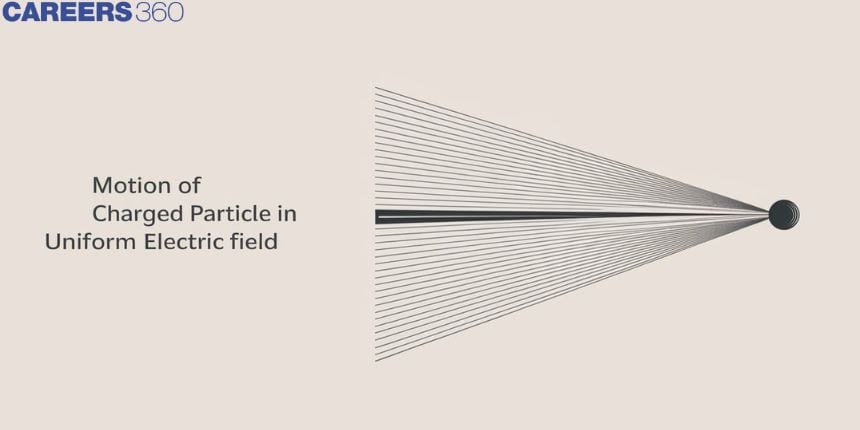Motion of charged particle in uniform electric field
Imagine you're holding a small ball in your hand and then release it. Gravity pulls it straight down, causing it to accelerate towards the ground. Now, picture a charged particle, like an electron, placed in a uniform electric field. Instead of gravity, the electric field exerts a force on the particle, causing it to move.
This Story also Contains
- The Motion of Charged Particles in a Uniform Electric Field
- Solved Examples Based on Motion of Charged Particle in the Uniform Electric Field
- Summary

In a uniform electric field, the force acting on a charged particle is constant, meaning the particle will experience uniform acceleration, much like the ball in free fall. The direction of this acceleration depends on the charge of the particle: positive charges accelerate in the direction of the electric field, while negative charges accelerate in the opposite direction. This concept is fundamental in understanding the behaviour of charged particles in various environments, such as in cathode ray tubes, particle accelerators, and even in the basic operation of electronic devices. In this article, we'll explain the details of how charged particles move in uniform electric fields and explore some real-world examples to illustrate this phenomenon.
The Motion of Charged Particles in a Uniform Electric Field
Whenever a charge is placed in an electric field, it will experience an electric force. There is an assumption that this whole system is placed in a gravity-free space. For this condition, electrical force is the only force acting on the particle. This net force will cause the particle to accelerate according to Newton's second law of motion. So we can write
F→e=qE→=ma→
Acceleration will be constant if the Electric field is uniform and a→=qE→m . The direction of acceleration or motion of a charged particle depends on its nature. If the charged particle is of positive nature then it will move or accelerate in the direction of the electric field. But in the case of the negatively charged particle, its motion or acceleration is in the opposite direction of the electric field. Here we can use the kinematic equation of motion since the acceleration is constant.
Recommended Topic Video
Solved Examples Based on Motion of Charged Particle in the Uniform Electric Field
Example 1: An electron having charge ‘e’ and mass ‘m’ is moving in a uniform electric field E. Its acceleration will be :
1) e2m
2) E2em
3) Eem
4) mEe
Solution:
When charged Particle is at rest in a uniform field
Force and acceleration
F=QEa=QEm
wherein
m - mass
Q - charge
E - Electric field strength
a=Fm=eEm
Hence, the answer is the option (3).
Example 2: The acceleration of an electron in an electric field of magnitude 50 V/cm, if the e/m value of the electron is 1.76×1011C/kg, is
1) 8.8×1014 m/s2
2) 6.2×1013 m/s2
3) 5.4×1012 m/s2
4) Zero
Solution:
a=eEm⇒a=1.76×1011×50×102=8.8×1014 m/s2
Hence, the answer is the option (1).
Example 3: An electron moving with the speed of m/s is shot parallel to the electric field of intensity. The field is responsible for the retardation of the motion of electrons. Now evaluate the distance travelled by the electron before coming to rest for an instant (mass of charge =1.6×10−19C).
1) 7 m
2) 0.7 mm
3) 7 cm
4) 0.7 cm
Solution:
When Charged Particle at rest in uniform field -
Force and acceleration
F=QEa=QEm - wherein m - mass Q - charge E - Electric field strength. Electric force qE=ma⇒a=QEm∴a=1.6×10−19×1×1039×10−31=1.69×1015u=5×106 and v=0∴ from v2=u2−2a s⇒s=u22a∴ Distance s=(5×106)2×92×1.6×1015=7 cm( approx )
Hence, the answer is the option (3).
Example 4: An electron (mass =9.1×10−31 kg and charge = 1.6×10−19C ) is sent in an electric field of intensity 1×106 V/m How long would it take for the electron, starting from rest, to attain one-tenth the velocity of light?
1) 1.7×10−12sec
2) 1.7×10−6sec
3) 1.7×10−8sec
4) 1.7×10−10secSolution
When charged Particle is at rest in a uniform field
Velocity -
v=QEtm=2QΔVm
wherein
ΔV= Potential difference.
By using
v=QEtm⇒110×3×108=1.6×10−19×106×t9.1×10−31⇒t=1.7×10−10s
Hence, the answer is the option (4).
Example 5: Particle A has a charge of +q and particle B has a charge of +4q with each of them having the same mass m. When allowed to fall from rest through the same electrical potential difference, the ratio of their speeds vAvB will become:
1) 2:1
2) 1:2
3) 1:4
4) 4:1
Solution:
We know that kinetic energy
K=12mv2=QV
Since m and V are the same so,
v2∝Q⇒vAvB=QAQB=q4q=12
Hence, the answer is the option (2).
Summary
If a charged particle is placed into a uniform electric field it will be subjected to a continuous force caused solely by this field. Consequently, a positively charged one will move in the direction of an electric field line, whereas a negatively charged one moves oppositely. Equations of motion for constant acceleration can be utilized in order to determine the direction and speed of these particles according to the time factor.